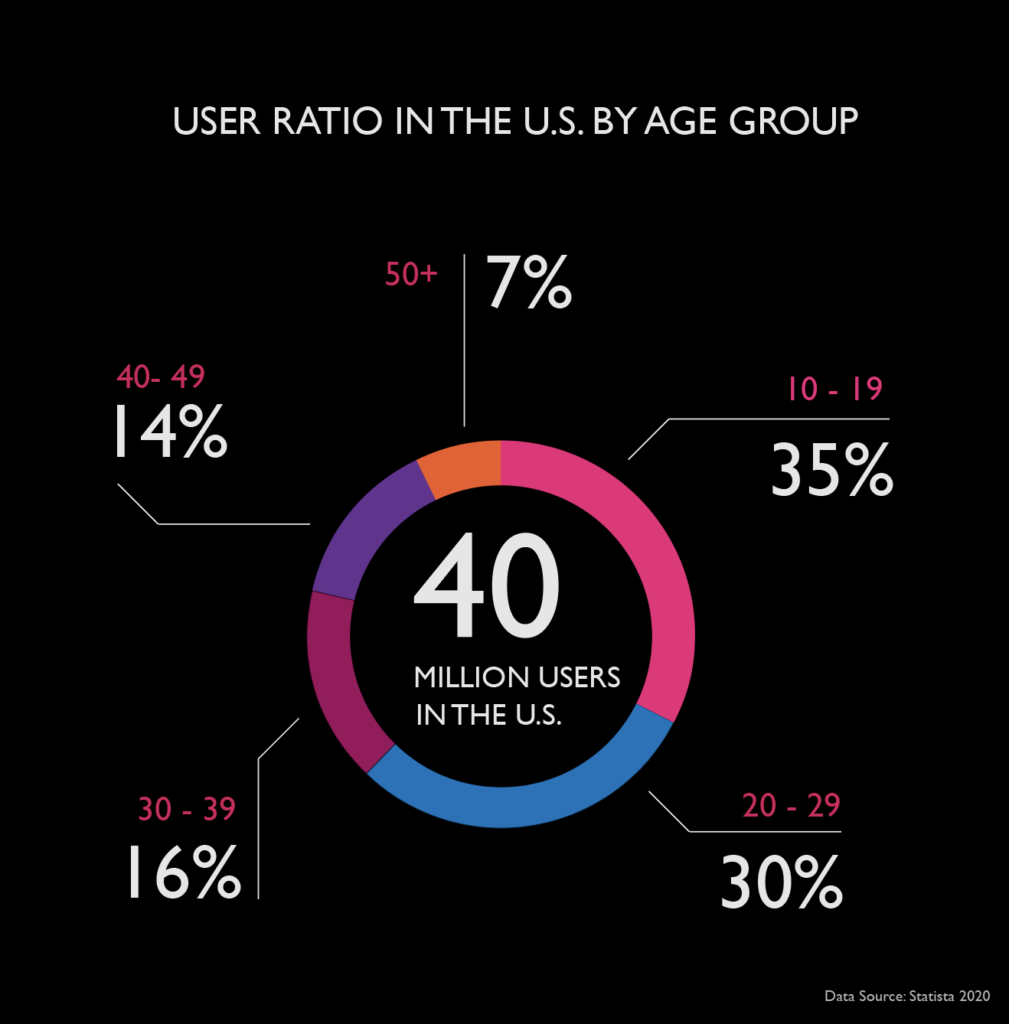Amid the hard politicking enveloping the U.S. and China, the first product to project genuine China cool—a devilishly addictive algorithm that quickly became the domain of millions of choreographing teens—has been caught up in a vicious geopolitical dance.
How addictive is TikTok? Its 800 million global users spend close to an hour a day on the app. It was the most downloaded program on Apple’s iOS App Store in 2019.

Outside of the U.S. 41 percent of TikTok’s users are teenagers. Image: Peter Huang.
What happened
President Trump has discussed banning TikTok, by executive order if necessary. Although he reversed that position today, he remains wary of the app and its reach. The threat stems from fears that an app owned by a Chinese company poses a danger to national security by granting access to the data of U.S. citizens who use the app.
In response, TikTok’s U.S. general manager announced, in a short video posted on the platform, that the app wasn’t going anywhere.
As this story went online, Trump okayed Microsoft’s purchase of the Chinese-owned video app if the deal can be completed by September 15. If the deal were to come about, Tiktok would not end its U.S. operations, but its future of global expansions could become less certain.
Why it matters
The issue marks a further escalation of U.S. tensions that began with an aggressive trade war in 2018 and most recently resulted in a tit-for-tat closure of consulates in Houston and Chengdu. A TikTok ban would anger many of the app’s nearly 40 million U.S. users and undermine a burgeoning giant in the entertainment industry.
Impact on ByteDance. A U.S. ban would represent a second setback to its global ambitions, following TikTok’s removal from India’s app stores in June — previously its largest user base, with 130 million users.
Though the setback would not necessarily be terminal. “I don’t see it stopping its efforts at globalization in the long run,” says Rui Ma, Co-host of Tech Buzz China Podcast, ByteDance has “always seen itself as a ‘born to be global’ company and I don’t see that changing. If anything, it should be more confident, based on the success of TikTok.”
Impact on Chinese companies in the U.S. If it happens, the TikTok ban would likely cool the ambitions of Chinese companies looking to launch or expand operations in the U.S.
“This is one more sign the U.S. is a hostile business environment, especially in the tech space,” says Ben Cavender, Managing Director at China Market Research Group. “There’s a feeling amongst Chinese executives that the U.S. isn’t worth the bother. Better to focus on growth at home and winning high potential markets lacking strong domestic players. In Southeast Asia, for example.”
This assessment will be reinforced by the efforts ByteDance has taken to comply with U.S. regulators. “ByteDance was willing to be as flexible as they could to effectively localize, but this isn’t about them,” says TechNode’s Elliot Zaagman. “This is about Washington and Beijing. ”
JT Takeaway: Culture in the Crunch
As bastions of tradition, cultural institutions are seldom seen as tech-savvy organizations keen to tap the latest social-media phenomenon. Coronavirus, however, has forced a full digital rethink. And this includes TikTok.
Museums embrace TikTok. The number of museums on TikTok is small but growing fast. Those that have embraced the app’s playful spirit have been rewarded with remarkable success. Florence’s Uffizi Gallery creates irreverent mashup videos with its Renaissance masterpieces, Madrid’s Prado has drawn 40,000 followers in its two months on TikTok, and snail puns have made an unlikely digital star of a Carnegie Museum of Natural History curator.
This momentum would most likely accelerate with ByteDance’s recent announcement of a $50 million fund focused on developing cultural content.
Effort to court younger audiences continues. In recent years, cultural institutions have increasingly incorporated “going young” into their outreach strategies. In TikTok, some institutions have discovered a successful opportunity to connect with Gen Z and Millennial audiences in a language they speak (or sing).
If it were to take effect, a TikTok ban wouldn’t end this courtship, but it would further complicate one of the great challenges facing cultural organizations in the U.S. and elsewhere in the West.



